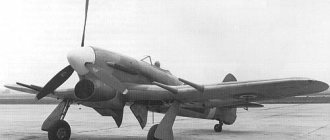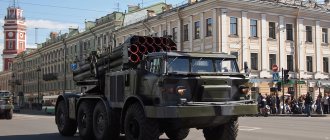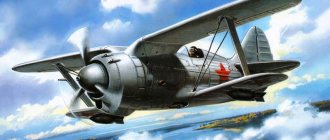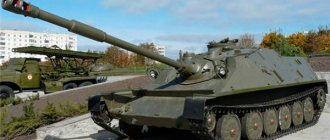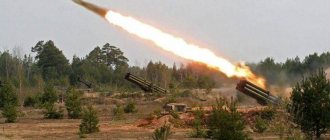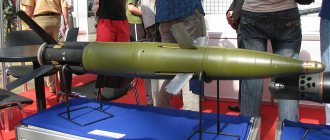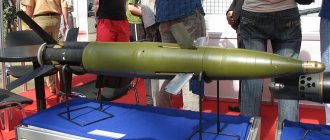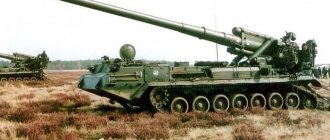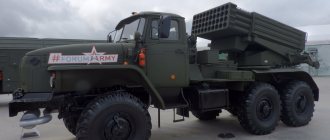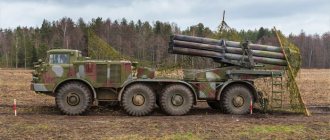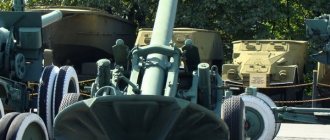The 9K57 Uragan MLRS is a Soviet multiple launch rocket system developed in the 70s. It is still used by the Russian army. The main task of this weapon is to defeat enemy personnel and other targets at distances from 10 to 35 km. The Uragan MLRS can be used to remotely lay anti-personnel and anti-tank mines.
The development of the complex was carried out by the Tula State Research and Production Enterprise "Splav", which previously created another famous rocket system - "Grad". Work on the creation of the 9K57 Uragan MLRS was led by General Designer Ganichev.
In terms of its main characteristics, the Uragan significantly surpassed the B-21 Grad: it is more powerful, has a longer firing range and can use a wider range of ammunition, which increases the versatility of this weapon.
The Uragan MLRS is in service with several dozen countries around the world; it has taken part in many conflicts and has repeatedly proven its high efficiency.
History of creation
In the mid-60s, the Soviet military received the excellent Grad MLRS, which at that time had no analogues in any of the armies in the world. However, the military needed another MLRS complex with slightly different characteristics: with a longer firing range and more powerful ammunition. Since 1963, the designers of the State Research and Production Enterprise “Splav” have proactively worked on the creation of such a MLRS. In 1967, a preliminary design of the system was ready, bench tests of various components were carried out, and experimental missiles were fired.
In 1972, field testing of the Hurricane and refinement of the rocket system began. At this stage, the designers were able to obtain the characteristics that the military required of them. The firing range of the new MLRS reached 35 km, its accuracy was significantly increased (it is 1.5 higher than that of the Grad) and the effectiveness of hitting the enemy. A salvo from one launcher covered an area of 42 hectares.
The designers of "Splav" were the first in the world to create a cluster warhead for a rocket launcher for MLRS. Since then, several types of cluster munitions have been developed for the Uragan; in addition to ammunition with fragmentation warheads, the missile can be equipped with anti-tank and anti-personnel mines.
In 1975, the Hurricane was put into service, and its production continued until 1991.
Afghanistan became the Hurricane's baptism of fire; Soviet troops widely used this MLRS throughout the conflict. The Uragan also took part in combat operations in Africa; the Syrian army used it against Israeli troops in the early 80s, and Russian federal troops used it in both Chechen campaigns. The 9K57 Uragan MLRS was actively used by both sides of the conflict in eastern Ukraine.
Description
The Uragan MLRS includes the following components:
- 9P140 combat vehicle;
- rockets;
- transport-charging machine;
- fire control complex;
- meteorological complex;
- educational equipment;
- car for topographic survey.
The main component of the Hurricane is the 9P140 combat vehicle, based on the ZIL-135LM vehicle with an 8x8 wheel arrangement. The artillery part consists of sixteen tubular guides, which are combined into a single package. The guides are mounted on a rectangular platform - a cradle. The swinging part is installed on a rotating base, which ensures azimuth alignment of the guides. Guidance is also possible using a manual drive.
Aiming in the vertical plane is possible in the range from +6° to +55°. The horizontal guidance angle ranges from – 30° to +30° from the longitudinal axis of the vehicle. Jacks are installed in the rear of the car, which increase stability when shooting.
The Hurricane is equipped with a panoramic sight and gun panorama, a walkie-talkie and a night vision device.
The tubular guides have a U-shaped groove, with the help of which the missile is given a rotational movement.
Shooting can be carried out either in one volley or in single shots. A variant of the so-called ragged salvo is possible, during which the first eight missiles are fired at intervals of 0.5 seconds, and the remaining eight - 2 seconds. The time of a regular salvo is 8.8 seconds, and a “ragged” salvo is 20. Firing can be carried out from the cockpit or remotely. The firing range reaches 35 km; if fire is fired at shorter distances, then special brake rings are installed on the head of the missile.
The ZIL-135LM car is equipped with two eight-cylinder engines with a power of 180 hp. With. every. The power plant is located behind the cab. The wheels of the rear and front axles are steerable, the machine is equipped with a tire inflation system.
A similar chassis is used for the transport-charging vehicle. It can carry up to 16 rockets. Loading can be carried out without special preparation, at any site, its time is 15 minutes. The transport-loading vehicle is equipped with a crane, a tray with a rammer, cargo trolleys, docking devices, electrical equipment and an alignment mechanism.
The simplest and most used type of rocket for the Uragan MLRS is the 9M27F with a high-explosive fragmentation warhead. The ammunition consists of a warhead and a rocket part. The warhead and fuse are located in the head part, and the solid propellant engine and stabilizers are located in the missile part. They (like those of the Grad) have the shape of a cylinder sector and open after the missile leaves the guide.
The Uragan 9M27K MLRS missile has a cluster warhead containing thirty fragmentation elements. They are located in five sections of six around the axis of the projectile. Each such element is equipped with its own stabilizers and contains 350 ready-made submunitions with high penetrating ability.
"Hurricane" became the first multiple launch rocket system that could be used for remote mining of terrain. At a given altitude, the warhead of the rocket is revealed by a powder charge, and the warheads are scattered over a certain area. The fuse of each mine is blocked by a delay system, which turns off after the ammunition lands. After this, the mines are put on combat duty.
As combat elements, the Uragan missile can carry anti-tank contact mines (explodes only after hitting them) and mines that react to the magnetic field of the combat vehicle. The latter have cumulative notches and can penetrate tank armor.
Also, the warhead of the missile can be equipped with PFM-1S anti-personnel mines (312 pieces). This mine has a plastic body and a small wing, which is designed to disperse ammunition over a large area. They are shaped like a butterfly or petal. Such mines were widely used by Soviet troops in Afghanistan, and the civilian population, especially children, suffered greatly from them.
The rocket can also be equipped with a volumetric detonating warhead.
From "Hurricane" to "Hurricane". welcome to Hell
In the system of the most important state documents there is also this: Military Doctrine of the Russian Federation. It represents a system of views officially accepted in the state on preparation for armed defense and armed defense of the Russian Federation. And the following concept appears in the Military Doctrine: “non-nuclear deterrence system” - a set of foreign policy, military and military-technical measures aimed at preventing aggression against the Russian Federation by non-nuclear means.
And any “measures” will always be translated into reality by specific people using specific types of weapons, military and special equipment. So let's look at one of the most interesting systems that can prevent this aggression. Which, if something happens that you really would like to avoid, can be successfully used both in military and armed conflicts, and in wars - local, regional and large-scale. We are talking about the domestic Uragan-1M multiple launch rocket system.
Let's start with a fresh example, kindly provided by the foreign press. Here’s what the Daily Mail, a mainstream English newspaper for the middle class, more than half of whose readers are women, wrote on November 13, 2016: “For the first time since the Cold War, Britain will place missile batteries on the border with Russia” - in Estonia, near the Leningrad and Pskov regions.” .
That is, in the enthusiastic words of the British mass press, “their GMLRS guided missiles,” launched from the American-made M270 MLRS multi-charge missile launcher, “will be able to blow up Russian tanks at a range of up to 80 kilometers.”
By the way, it was the Royal Navy that pioneered the use of missile weapons in Europe. Having received new equipment borrowed from India, the British burned Copenhagen on September 4, 1807, with Congreve rockets. And the British also had the concept of fleet in being - the ability of the fleet to influence world politics without using it, by the mere fact of its presence.
So let's look at where Russian non-nuclear deterrent weapons came from and how they developed, capable of influencing politics by the mere fact of their presence.
To do this, let's look to the past. Ninety years ago, in 1926, the work “The Scope of Operations of Modern Armies” was published in Moscow. It was written by Vladimir Kiriakovich Triandafillov. What kind of troops did Vladimir Kiriakovich rely on in his work of 1926? Triandafillov called artillery the main means of suppression and breakthrough, including heavy artillery of the reserve of the main command. It was she who was supposed to destroy the enemy both on the front line and in the depths of defense. This task was quite feasible for the artillery of that time: even taking into account the concept of a deep operation, the depth of the division’s defense, according to the regulations of the thirties, was set at ten kilometers. The Russian 42-line (107 mm) heavy field gun of the 1910 model had a firing range of 12.5 km.
The success of deep surgery is ensured by its transience. The fire had to be not only concentrated in place, but also concentrated in time. It must attack the enemy suddenly, with all its might, without allowing it to come to its senses - to bring up reserves, repair trenches and barbed wire, restore firing positions... And this goal was served by the weapon system that became the favorite visual symbol of the Great Patriotic War for decades - “Katyusha”. Work on it began in the USSR in 1930, in parallel with the development of the theory of deep operations by staff officers.
The industrialization of the country made it possible to give the rocket a durable steel body of high elongation; the M-13 projectile had a length of 1415 mm with a caliber of 132 mm. Seven kilograms of grade N nitroglycerin gunpowder accelerated the product to a speed of 355 m/s, which made it possible to deliver five kilograms of tol to a distance of eight kilometers. By 1944, in the M-13DD modification, the projectile length increased, amounting to 2229 mm, and the fuel mass increased - it reached 14.64 kg, which made it possible to reach a speed of 520 m/s. This provided a range of 11,800 m, thanks to which it was possible to cover the entire depth of the defense of Nazi divisions with fire.
The accuracy of a single missile was low. Lateral deviation is 300 m, range spread is 135 m. Moreover, this is according to the ballistic tables of 1957, when the quality of shells was slightly increased compared to the accelerated production of wartime. But the creators of the Katyushas turned low accuracy from a disadvantage into an advantage. On the BM-13 combat vehicle, a package of eight channel beams was mounted on the chassis, with a guide chute on top and bottom of each. This made it possible to fire sixteen shells in 8–10 seconds. Directive of the Supreme High Command Headquarters No. 002490 prohibited the use of Katyushas in quantities of less than a division, that is, firing from less than three batteries of four vehicles each. A simultaneous salvo from a dozen vehicles made it possible to provide continuous coverage of a target distributed over the area.
The massive use required a huge amount of ammunition: in total, the domestic industry produced more than fourteen million rockets during the Great Patriotic War, which, by the way, contrary to popular belief, did not carry a thermite charge: the incendiary effect was provided by the steel body, heated up during engine operation. The high-explosive charge was detonated in such a way that it gave an axisymmetric blast wave. It tore the hull into long fragments that retained accumulated heat well - much like the red-hot cannonballs of the era of wooden ships... So the Guards mortars worked well against the Nazis and their allies!
Then there was the Cold War. The development of technology, the emergence of nuclear weapons, the saturation of troops with equipment. By the early seventies of the twentieth century, Pentagon regulations determined the depth of defense of a US mechanized division in the European theater of operations to 30 km. During the offensive, the depth of battle formations could stretch up to 40 km. This determined the tactical and technical requirements for the then domestic MLRS systems. After all, shoulder to shoulder with the Yankees stood the half-million-strong Bundeswehr by the end of the sixties, a significant part of whose command staff consisted of Wehrmacht veterans, 12 divisions with means of delivering nuclear weapons - from 155-mm howitzers to Sergeant missiles... So at the end of 1968 in the USSR Work began on the creation of a new multiple launch rocket system.
It was initially christened “Grad-3”, but during the development process it began to be called “Hurricane”. The caliber of the rockets was chosen to be 220 mm, length - 4832 mm, weight - 280 kg; it carries a warhead weighing 99 kg. The Hurricane's firing range reaches 35,800 m, which made it possible to penetrate the entire depth of the battle formations of the then NATO divisions with fire. Depending on the target, the missiles could carry either 100-kilogram high-explosive monoblocks, preferable when hitting command posts, communications centers, military-industrial facilities, or cluster warheads with 30 high-explosive fragmentation elements - they are effective in hitting manpower, lightly armored vehicles, artillery, airfields.
The missiles were launched from 16 tubular guides placed on the chassis of the BAZ-135LM wheeled vehicle. In flight, the projectiles were stabilized by rotation around their axis, which makes it possible, at wind speeds of up to 20 m/s, to correlate the dispersion with the affected area.
Already for the Katyushas there were shells with “improved accuracy” - M-13UK. They were “twisted” using nozzles directed at an angle to the axis of the projectile. This made it possible to reduce the effect of thrust eccentricity. And the “hurricanes” rotated much faster, which makes the tails unnecessary and reduces the side windage. A Hurricane salvo covers an area of 42.6 hectares, making it an extremely effective means of hitting area targets. But this was already the range limit for unguided missiles. The inevitably accumulating deviations unacceptably increased the scattering. Then the engineers had to look for another solution.
It was found by designers of NPO Splav, led first by Alexander Ganichev and then by Gennady Denezhkin. And it was embodied in the Smerch MLRS, which entered service with the Soviet army in 1987. The caliber of the Smerch missiles is 300 mm, length is 7600 mm, weight is 800 kg, of which the warhead accounts for 280 kg. With the missiles of that time, it had a range of 70 km. Shooting at such a distance was made possible by a unique idea: an inertial control system was introduced into each rocket, which was quite simple, technologically advanced and cheap.
The accuracy of this control system, or correction as it is called, was lower than that of the control systems of “classical” guided missiles. But she didn’t need to launch every missile exactly to the target. It was only necessary for a dozen Smerch missiles, fired from tubular guides in 38 seconds, to land at maximum distance with accuracy ensuring the creation of a continuous destruction field - 672 thousand square meters - two-thirds of a square kilometer... Depending on the mission of the rocket can carry high-explosive, thermobaric, cluster warheads with fragmentation, homing armor-piercing, fragmentation-cumulative elements.
And now, having outlined the background, we can move on to the Uragan-1M system itself, index GRAU - Main Rocket and Artillery Directorate - 9K512. A 9A53 combat vehicle fires at the target. It is placed on the chassis of an eight-wheeled, with four driving axles, MZKT-7930 tractor produced by the Minsk Wheel Tractor Plant. Unlike the old MAZ-543 tractors, which used tank engines, the MZKT-7930 will use new Yaroslavl automobile-type diesel engines that have a longer service life. This provides the Uragan-1M system with high operational mobility and the ability to be transported along roads under its own power over long distances.
The most interesting property of the combat vehicles of the Uragan-1M complex is their dual caliber. It can fire both Hurricane and Smerch missiles. This is achieved during reloading, when two packages are installed on the vehicle, each of which contains either six Smerch shells, or fifteen Hurricane shells, 12 or 30 missiles in a salvo, respectively. The latest Smerch missiles use a new mixed fuel, which allows them to increase their firing range to 120 km! But ancient black gunpowder was precisely a “mixed fuel” - a mechanical mixture of sulfur, saltpeter and charcoal. So the development spiral again brought back the old technologies, but at a completely different level!
Why then the bicaliber? After all, it seems that the further, the better? But targets deep in the enemy’s defenses will be at different ranges, and each one will be effectively targeted by a different vehicle from the Russian Army’s weapons system. Short-range targets - up to 10 km - will be effectively burned out by the Sunshine, since it is built on a protected tank chassis, which provides high tactical maneuverability, allowing you to crawl close to your adversary. "Uragan-1M" does not need this: by suddenly entering firing positions, it can provide unexpected fire on the enemy from long distances.
With Uragan missiles, its minimum range is from 8 km - just where the Solntsepek stops working - and up to 36 km with old missiles, which, apparently, are still in warehouses. The minimum range of the Smerch is 20 km and up to 120 km with new missiles. The type of ammunition and type of warhead will be chosen by the artillery chief depending on the type of target and mission of the operation. War is already a very expensive business, so where possible, it is advisable to use unguided Hurricane projectiles, which spend less gunpowder to deliver the projectile over shorter ranges, leaving the more expensive Smerchs for distant targets.
An important part of the complex is the 9T249 transport-loading machine. It is also made on the MKZT-7930 wheeled chassis. Unlike the TZM-T of the Solntsepek complex, it does not need to get closer to the front line - it must transport a new batch of missiles from warehouses or transport hubs at maximum speed and, having loaded the 9A53 combat vehicle with them as quickly as possible, depart for new ammunition. That is why a wheeled chassis was chosen, and the loading speed is achieved by installing standard packages, 6 or 15 shells each, but of the same size.
That is, the new MLRS systems of the Russian army make it possible to reach targets at a distance of 120 kilometers, covering an area of 0.7 square kilometers with each salvo. And transport-loading vehicles will ensure the prompt delivery of ammunition. So there is no need to send aircraft and risk the lives of the pilots, because the MLRS can be reliably covered with the help of multi-layer air defense. So, weapons that initially began to develop for the needs of a deep defensive or offensive operation now acquire the potential for strategic deterrence. As the respectable The Times wrote on November 20, 2016: “Britain has backtracked on plans to send medium-range rockets to Estonia amid concern about how the Kremlin would react”—the British have changed their minds about deploying missiles in the Baltics.
Well, they had a whole week to think about two numbers: 80 kilometers of range for the British M270 MLRS versus 120 kilometers for the Russian Uragan-1M... Everything is amazingly simple and clear and makes you think about resolving disagreements through non-violent and civilized negotiations. This is how non-nuclear deterrence is achieved. "Uragan-1M" preserves peace and tranquility by the very fact of its existence...
Technical characteristics of the 9K57 Uragan MLRS
Below are the tactical and technical characteristics of the Uragan multiple launch rocket system.
| Characteristics of the combat vehicle | |
| Number of guides | 16 |
| Charged mass with calculation, t | 20 |
| Weight without shells and crew, t | 15,1 |
| Vertical aiming angle (firing zone), degrees | +6…+55 |
| Maximum guidance speed for electric drives, deg/s | 3 |
| Minimum guidance speed for electric drives, deg/s | 0,2 |
| Full salvo time, s: | |
| at a constant pace | 8,8 |
| at a “ragged” pace | 20 |
| Firing range, km: | |
| maximum | 35,8 |
| minimum | 5 |
| Time, min: | |
| transfer from traveling to combat position | 3 |
| loading | 14 |
| preparation for emergency relocation | 1,5 |
| Chassis | Zil-135LM |
| Chassis weight, t | 10,6 |
| Dimensions, m: | |
| in a stowed position | 9.63x2.8x3.23 |
| in combat position | 10.83x5.34x5.24 |
| Maximum speed, km/h | 65 |
| Cruising range, km | 570 |
| Fording depth, m | 1,2 |
| Calculation of peacetime/wartime, persons | 4 (6) |
Ammunition Specifications
| Characteristics of rockets | |||||
| Index | MS type | Weight, kg | MS mass, kg | Length | Firing range, km |
| 9M27F | high-explosive fragmentation | 280 | 99 | 4833 | 10-35,8 |
| 9M27K | cassette, fragmentation | 271 | 89,5 | 5178 | 7,5-35 |
| 9M27K2 | anti-tank mining | 271 | 89,5 | 5178 | Jul.34 |
| 9M27K3 | anti-personnel mining | 271 | 89,5 | 5178 | Jul.34 |
| 9M51 | volume-detonating | 256 | 143,5 | 5147 | May.13 |
| 9M59 | anti-tank mining | 270 | 90 | 5178 | Oct.35 |
MPP Uragan-1M (Powder fire extinguishing module)
Autonomous powder fire extinguishing module (MPF). Used to fight fires (fires) of categories: A, B, C and live electrical equipment. OTV weight 6 kg.
One of the most effective methods of fighting fires is the method of depriving the fire of oxygen, without access to which it will naturally die out. And this is best met by powder fire extinguishing modules (PFMs), which are used in enterprises, industries and other large-area facilities. These fire extinguishing systems have proven themselves in a wide variety of situations. One of the advantages of MPPs is the ability to install them to fight fire both in confined and open spaces. These modules are capable of successfully fighting fires of all categories, and do not require human intervention, being automatically activated in the event of a fire.
Main technical characteristics of MPP Uragan-1M:
| Powder fire extinguishing module MPP Uragan-1M | |
| Weight of fire extinguishing agent charge (FCA) | 6 kg. |
| Module housing capacity | 6.55 l. |
| Module weight | 9.2 kg. |
| Application area | for localizing and extinguishing fires of classes A, B, C and electrical equipment under voltage up to 1000 V in industrial, warehouse, residential, commercial, administrative premises and garages |
| Protected area when extinguishing a class A model fire | up to 55 m² |
| Protected area when extinguishing a class B model fire | up to 25 m² |
| Protected volume when extinguishing a model fire of class A | up to 162 m³ |
| Protected volume when extinguishing a class B model fire | up to 36 m³ |
| Maximum rank of class B outbreak | 21B |
| Dimensions (diameter/height) | 280/260 |
| Safe current for checking module electric starting circuits / Starting current | no more than 0.03 A / 0.12 A |
| Operating temperature | -50°C…+50°C |
| Electrical resistance of the starting device | 8-16 Ohm |
| Response temperature | — |
| Recharge time | at least once every 10 years |
| Installation height | 3±0.5 m |
| Degree of protection from external influences | — |
Powder fire extinguishing modules (PFM) are used:
• In case of ignition of solids (class A) • In case of ignition of flammable and lubricating liquids, fuel (class B) • In case of ignition of gases (class C) • In case of ignition of electricity. installations under voltage up to 1000V (class E)
Powder fire extinguishing modules (MPF) ARE NOT APPLIED:
• When ignition of metals that do not require access to oxygen
Contents: Powder fire extinguishing module (PFM), fasteners, box, passport with instruction manual
Please note that before you start using this model of the automatic powder fire extinguishing module MPP Uragan-1M, you should check its characteristics for compliance. Our company is not responsible for the use of automatic powder fire extinguishing modules for purposes other than their intended purpose.
Buy and order delivery of a powder fire extinguishing module (FPP) in the regions of the Russian Federation (shipping by transport companies) and zones of the Customs Union.
Powder fire extinguishing module MPP Uragan-1M , as well as other MPP models (or their analogues), you can order and buy through our online store of powder fire extinguishing modules , or simply order delivery in Moscow to.
(We provide free delivery only for orders over 60 rubles, delivery of powder fire extinguishing modules in Moscow - 500 rubles, in the Moscow region - 1200 rubles. Pickup from the Belorusskaya metro station).
If you cannot choose the right model yourself, or you have any questions about powder fire extinguishing modules (PFMs), call us for a consultation.
